Servicios Personalizados
Articulo
Indicadores
Links relacionados
-
 Citado por Google
Citado por Google -
 Similares en Google
Similares en Google
Compartir
Acta Commercii
versión On-line ISSN 1684-1999
versión impresa ISSN 2413-1903
Acta Commer. vol.23 no.1 Johannesburg 2023
http://dx.doi.org/10.4102/ac.v23i1.1111
ORIGINAL RESEARCH
Influence of institutional quality, foreign direct investment and international trade on tourism inflow, South Africa
Oyebanji J. Ibitoye; Ewert P.J. Kleynhans
School of Economic Sciences, Faculty of Economic and Management Sciences, North-West University, Potchefstroom, South Africa
ABSTRACT
ORIENTATION: The South African Tourism Act of 2014 on improving the level of tourist attraction for sustainable development in South Africa has been promulgated to ensure quality tourism products and improve the growth and development of the tourism sector and ensure sustainable revenue generation.
RESEARCH PURPOSE: This article investigates the dynamic impact of institutional quality, foreign direct investment and international trade on tourism inflows in South Africa from 1996 to 2019.
MOTIVATION FOR THE STUDY: The study examines the impact of institutional quality, foreign direct investment and international trade on tourism inflow in South Africa. Investigations on the relationship between institutional quality and tourism are limited and filled with disparities. The study also adopted different measures to view institutional quality. South Africa is to benefit from this empirical investigation.
RESEARCH DESIGN, APPROACH AND METHOD: World Bank Indicators were used as the main data source. Variables used for the analysis of the multivariate framework include international tourism receipts as a percentage of total exports, foreign direct investment, as a percentage of GDP, net inflow of investment, international trade, a combination of imports and exports gross domestic product, and political stability.
MAIN FINDINGS: The bound testing approach found cointegration among these variables. This study found a positive relationship between tourism inflow and international trade and between tourism inflows and regulatory quality, both in the short- and long-term. Unidirectional causality running from regulatory quality to tourism inflow in South Africa was also established.
PRACTICAL/MANAGERIAL IMPLICATIONS: Government should ensure good institutional qualities that will attract tourism to enhance international trade and economic growth in the long term.
CONTRIBUTION/VALUE-ADD: The result indicated that good regulatory quality improves attracting of tourists in South Africa. The volume of tourism inflows will assist in economic growth and increase foreign direct investments and other forms of international trade.
Keywords: institutional quality; tourism; international trade; economic growth; South Africa.
Introduction
This article investigates the dynamic impact of institutional quality, foreign direct investment (FDI) and international trade on tourism inflow in South Africa. The quality of a nation's institutions determines the effectiveness of the trade generated from international interactions. Institutional quality also influences the welfare of the people and the level of trade liberalisation. The quality of domestic institutions is also a good determinant of the relationship with other countries, given that the trust to get value in the form of payment for goods supplied is an important concern for foreigners. This assessment of the risk of conducting business is a condition for the volume of goods that are supplied to the country by foreigners (World Trade Organization 2004). The assessment of the risk of conducting business can be clearly understood from the idea of Greif (2006) who regards institutions as a composition of beliefs, values, rules and social factors, and how organisations in a particular society or country jointly ensure regularity.
In the aspiration for regularity in societies and countries around the world, several institutions and governments have inaugurated different initiatives, such as the World Bank anti-corruption strategy of 1997, the convention of combating crime by the Organization for Economic Co-operation and Development (OECD) in 1999 and the anticorruption treaty of the United Nations in 2003 (Meon & Sekkat 2007), and as part of the report of the Portfolio Committee on Trade and Industry in the South African revised Industrial Policy Action Plan (IPAP) of 2021.
The Portfolio Committee on Trade and Industry in the South African revised Industrial Policy Action Plan focuses on the tariffs of manufacturing, and other production sectors of the economy and emphasises the need to ensure more effective enforcement of South Africa's trade laws in various forms, which include custom fraud and illegal importation of goods and services that more often threaten the growth of domestic productive capacity and employment. In addition, the programme also stresses the need to give more support to South Africa's standards, quality assurance, accreditation and metrology (SQAM). This support could ensure improvement in export orientation, subdue the effect of non-tariff barriers to trade and ensure adequate protection for the domestic markets from the effects of unsafe and poor-quality imports (Department of Trade and Industry [DTI] 2021).
Countries in the world that experienced persistent growth in tourism have been seen as one of the leading drivers of economic growth in the 21st century. The South African tourism industry has continued to experience reasonable growth since the post-apartheid period of 1994 has made the sector highly ranked in terms of the gains from exchange earnings in South Africa (Henama 2013, 2018). However, tourists and investors in the world review some salient factors before investing or planning a visit to any country. These factors include exchange rate, transportation costs, local culture, poverty level, terrorism, political stability, infrastructure and institutional quality (Meo et al. 2021; Nathaniel 2020)
The need to ensure appropriate institutional quality that promotes trade liberalisation and economic growth has prompted a plethora of investigations in the literature. The investigations range from the relationship between institutional quality and economic growth to FDI. Some researchers have investigated the impact of institutional quality or governance as drivers of economic growth, for instance (Asghar, Qureshi & Nadeem 2015; Rodrik 1999; Teles 2007).
The effect of institutional quality or governance on economic growth, FDI and attracting tourists is not without disparities in the results of the empirical investigations, as some studies found a positive relationship (Ali, Fiess & MacDonald 2010; Asghar et al. 2015; Meon & Sekkat 2007; Tsai 1994), and others found a negative relationship between institutional quality and economic growth, FDI and tourism (see Asghar et al. 2015; Asiedu 2002).
The relationship between institutional quality and the level of tourism in a country is, therefore, also very important for researchers, tourists and policymakers. Despite the importance of this investigation, the literature has witnessed very few contributions from economists, political scientists and tourists (Jogaratnam et al. 2005; Khan et al. 2020; Kim et al. 2018). An empirical investigation concerning institutional quality and the level of tourism in Africa, especially in South Africa, is yet to benefit in the literature.
The aim of the present article is, therefore, to investigate the dynamic impact of institutional quality, FDI and international trade on tourism inflow in South Africa. This study contributes to the existing knowledge from the South African perspective by adopting time series data to investigate the linkages among institutional quality, FDI, international trade and tourism.
The remainder of the article is structured as follows: (1) the section 'Literature review' briefly reviews the existing literature; (2) the section 'Research methodology and design' describes the data used and sources, as well as the econometric model; (3) the section 'Results' analyses the empirical models and results and (4) the 'Conclusion' section concludes the article.
Literature review
The society views tourism as invisible export as income is generated from tourism in the same vein as the export of agricultural produce or manufactured goods (Ionannides & Timothy 2010). This assertion has increased the theoretical argument surrounding the relationship between international trade theory and tourism. The relevance of the theory of comparative cost advantage and more recent trade theories concerning intra-industry trade to the economy of tourism was argued by Sinclair and Stabler (1997).
The review of the related literature was conducted from three different directions with regard to institutional quality; these include: (1) institutional quality and economic growth, (2) institutional quality and FDIs and (3) institutional quality and the level of tourism inflow. This literature commences with the findings of North (1990), who investigated the relevance of institutions as a determinant of investment and economic growth and was followed by the influential works of Knack and Keefer (1995).
Investigations into the relationship between institutional quality and economic growth show disparities concerning the econometric techniques used and the period of studies as some investigations divided the studies into different regimes, rule of law (RL) and democratic periods. The relationship between institutional quality and governance started with North (1990). The author investigated the relevance of institutions as a determinant of investment and economic growth. Kebede and Takyi (2017) found a long-term relationship between economic growth and institutional quality in sub-Saharan African (SSA) countries by adopting the system generalised method of moments (GMM) technique. They found the tautology that institutional quality causes economic growth, and the economy on the other hand is a significant determinant of institutional quality.
Asghar et al. (2015) found that the quality of legal institutions has a positive impact on economic growth in 13 Asian developing countries by adopting the panel autoregressive distributed lag (ARDL). The political and economic institutions were found not to have an impact on economic growth. Similarly, Jadhav (2012) found that economic factors are more effective than institutional quality in determining the amount of FDI in the countries Brazil, Russia, India, China & South Africa (BRICS) from 2000 to 2009, after adopting the multiple regression econometric technique. Asamoah, Adjasi and Alhassan (2016) also found that the interaction between macro-economic uncertainty and institutional quality lowers the negative effect of macro-economic uncertainty on the stock of FDI in SSA countries after employing the generalised autoregressive conditional heteroscedasticity (GARCH) model.
By applying the regression analysis to 22 SSA countries between 1984 and 2000, Asiedu (2005) found that FDI promotion may be negatively affected by corruption and political instability. Esew and Yaroson (2014) adopted the vector error correction model (VECM) between 1980 and 2011 and found that FDI inflows into Nigeria are negatively influenced by political stability and the level of corruption. Soeng, Cuyvers and Sok (2017) found that institutional quality and political risk are important factors in promoting FDI inflows to Cambodia from 1985 to 2014, using the random effect estimation procedure of a panel data analysis. Asif and Majid (2018) found a significant relationship both in the long- and short-term between institutional quality and FDI after adopting the ARDL approach. Anwar and Afza (2014) observed that political instability and terrorism were detrimental to the growth of FDI investment in Pakistan between 1980 and 2010 by utilising the autoregressive moving average (ARMA) research and ordinary linear squares regression techniques.
Nondo, Kahsai and Hailu (2016) found a significant relationship between institution quality and FDI among 45 SSA countries between 1996 and 2007 by adopting fixed effects estimation techniques. Consistent with these investigations, Buchanan, Le and Rishi (2012) found that good institutional quality was a good determinant of FDI for 164 developed and developing countries between 1996 and 2006. Chaib and Siham (2014) established that economic institutions, voice and accountability had impacts on the level of FDI in Algeria between 1995 and 2011, applying co-integration and VECM techniques.
Jadhav (2012) found that effective control of corruption, representation (voice) and accountability, regulatory quality (RQ) and RL are potential institutional and political determinants of FDI among the BRICS, between 2000 and 2009, by adopting multiple regression. Muhammad et al. (2011) adopted the panel regression technique on seven South Asian countries from 1996 to 2007 and established that institutional quality has a key role in attracting FDI to the country. From another angle, Mishra and Daly (2007) found that institutional quality in the host country has a positive effect on the amount of FDI stock from the source country, utilising the least square regression technique on OECD countries from 1991 to 2001. Fukumi and Nishijima (2010) established a positive and symbiotic relationship between FDI and institutional quality in 19 countries in Latin America and the Caribbean countries after employing the simultaneous equation technique.
In the first quantitative investigation concerning the impact of political violence and tourism attraction, Neumayer (2004) found that politically motivated violence and human rights violations impact negatively on a tourism attraction by employing a fixed-effects panel estimator. Ghalia et al. (2019) established that institutional quality and absence of conflict are good drivers of tourism flows for both source and destination countries. Kim et al. (2018) found that high institutional quality has a positive impact, increasing tourism from panel data drawn from 108 countries between 1996 and 2011. Khan et al. (2020) showed that the inflow of tourism among the Asian Pacific countries is based on asymmetric changes in institutional quality by adopting the nonlinear ARDL approach. Álvarez et al. (2018) established that institutional quality is a good determinant of the volume of trade after employing the Poison pseudo maximum likelihood estimation methods on bilateral trade of 186 countries between 1996 and 2012.
Meon and Sekkat (2007) found that institutional quality is essential for the promotion of the export of manufactured goods after employing the least square regression method on a panel of countries from 1990 to 2000. The regression results of Wadhawan and Kandiero (2003) show that institutional quality has a significant effect on the level of trade openness from 1985 to 1990, from 1990 to 1995 and from 1995 to 2000. In the investigation of 40 SSA countries, adopting the system GMM, Ibrahim and Law (2016) found that institutional quality assists to decide the impact of trade on the environment.
Salman et al. (2019) adopt the fully modified Ordinary Least Squares (OLSs) and Dynamic Ordinary Least Squares methods to determine the existence of long-run relationship among institutional quality and economic growth. The study also adopts the VECM Granger causality test to determine the direction of causality between the variables for three Asian countries (Indonesia, South Korea and Thailand) for the period 1960-2016. The study also established a direct relationship between economic growth and institutional quality. The VECM causality test also finds a unidirectional causality running from institutional quality to economic in the short- and long-run periods.
Epo and Nochi Faha (2020) adopt a panel smooth transition regression and a system of dynamic panel-data instrumental variable regression to determine the relationship between economic growth, natural resources and institutional quality for 44 African countries from 1996 to 2016. The study finds a significantly unsatisfactory result for the non-linear relationship between economic growth and natural resources when the RL and regulations are taken as proxies for institutional quality for natural resources rent as a proportion of the total gross domestic product (GDP) and share of ores and metals taken as a percentage of the total exports.
Abubakar (2020) adopts the OLS and the Johansen Cointegration tests to determine the relationship between institutional quality (effective governance index and contract intensive money) and economic growth in Nigeria for the period 1979-2018. The study showed a positive relationship between contract intensive money and economic growth; on the other hand an indirect relationship was established between economic growth and effective governance index.
Yakubu (2020) utilised the ARDL framework to determine the relationship between institutional quality and FDI in Ghana from 1985 to 2016. The result of the study shows a direct relationship between institutional quality and FDI.
Adegboye et al. (2020) adopted the fixed and random effect model to determine the relationship between institutional quality and FDI for 30 SSA countries from 2000 to 2018. The result showed that institutional quality affected the inflow of FDI into the African countries.
Bouchoucha and Benammou (2020) examine the impact of institutional quality through the lens of governance on FDI inflow into 41 African countries by adopting the static panel data approach (fixed and random effects), and the dynamic panel approach. The study found a direct relationship between control of corruption and FDI inflow among the countries.
Mushtaq, Thoker and Bhat (2021) studied the impact of institutional quality on international tourism inflow in India for the period 1995-2016 by adopting the ARDL of 30 originating countries for India. The study found a direct relationship between institutional quality like RL, control of corruption and RQ and tourism inflow. An indirect relationship was found between government effectiveness and tourism inflow. Meo et al. (2021) examined the effect of institutional quality on tourist arrivals into Pakistan from 1984 to 2017 by adopting the non-linear ARDL approach. The study found that an improvement in institutional quality will assist in improving tourist attraction in Pakistan.
From an intensive review of the literature, it is evident that the effect of institutional quality or governance on economic growth is not without disparities in the results of the empirical investigations, as some studies found a positive relationship (see Asghar et al. 2015; Tsai 1994), and others found a negative relationship between institutional quality or governance and economic growth (see Asghar et al. 2015).
Mixed results were also found in the studies that divided the investigation period into regimes (RL and democracy). Butkiewicz and Yanikkaya (2006) found better growth experience from democratic institutions, while Dollar and Kraay (2000) found that democracy has no significant effect on income; however, RL was found to have a positive effect on per capita income and bettering the lives of the poorest. There are also some empirical investigations on the direction of causality between institutional quality and economic growth. Kebede and Takyi (2017) found a unidirectional causality, where the causality is moving from economic to institutional quality alone, whereas Asghar et al. (2015) found causality running from institutional quality to economic growth.
Empirical investigations relating to institutional quality and FDI also started with the seminal work of Schneider and Frey (1985). Since then, the literature has enjoyed several related investigations (Jude & Levieuge 2016; Soeng et al. 2017). The impact of institutional quality on the level of FDI in particular countries or regions is not devoid of disparities in their results either.
Meon and Sekkat (2007) and Ali et al. (2010) found that institutions are a good determinant of FDI; however, in the study related to the impact of institutions at the sectoral level, the authors did not find a significant impact of institutions at the primary sector, whereas institutional quality was found to have a significant impact on the services and manufacturing sectors. There are, therefore, disparities in the investigation of the impact of institutional quality on the level of FDI. Asiedu (2002) found no significant impact of political risk on FDI in 71 developing countries, with 32 SSA countries and 39 non-SSA countries, whereas in another study by Asiedu (2006) on 22 African countries, it was found that political stability, lower corruption and a reliable legal system promote FDI.
Research design and methods
Data collection and anlaysis
The data used in the current study ranged from 1996 to 2019, which is the maximum number of observations based on the availability of data for South Africa from the World Bank Indicators; which was also accepted as a good aspect as it excludes the effect of the coronavirus disease 2019 pandemic. The selected variables used for the analysis of the multivariate framework include international tourism receipts (TRM), which is a percentage of total exports. Foreign direct investment, as a percentage of total gross domestic product (GDP), is the net inflow of investment for a continued management interest of at least 10% of the voting stock. International trade (TRADE), as a percentage of GDP, is the combination of imports and exports as a portion of GDP. Gross domestic product is the percentage of growth experienced in GDP over a period. Political stability and absence of violence and/or terrorism (PSA) view the possibility of political violence, terrorism and instability in South Africa over the years. An RQ estimate reviews the ability of the government of South Africa to promote private sectors by way of formulating and implementing appropriate policies and regulations. Rule of law considers people's confidence in the laws of society and how the police and courts have managed the issues of crime and violence. The main statistical data are summarised in Table 1.
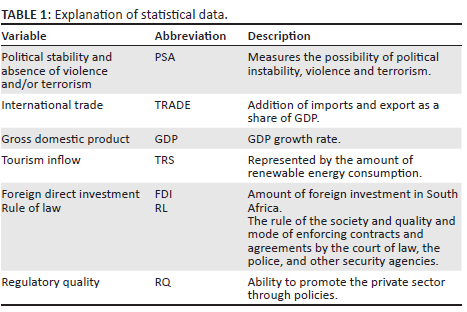
Descriptive statistics
Table 2 shows the summary statistics of the mean, median, maximum, minimum, standard deviation, skewness and kurtosis of the variables adopted in this study. TRADE has the highest mean value, followed by TRM, although GDP has a higher standard deviation than TRM, and FDI has a higher skewness level and kurtosis than TRM. Additionally, the maximum value is positive for all the variables; the minimum is also positive for all, except RL, PSA and GDP. TRADE, RQ, RL and FDI are positively skewed or are skewed to the right, while RL, PSA and GDP are negatively skewed. Tourism receipts, RL and FDI are leptokurtic because they have kurtosis values greater than three or a kurtosis level that is greater than the normal distribution, while, TRADE, RQ, PSA and GDP have kurtosis values below the normal distribution.
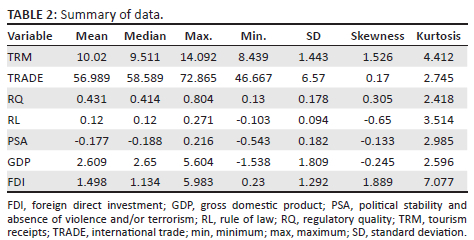
Figure 1 presents the analysis of international TRM in South Africa as a percentage of total exports from 1996 to 2019, FDI, net inflows as a percentage of GDP, trade as the combination of import and export as a percentage of GDP, and the annual GDP growth rate. According to Figure 1, TRADE has the highest value and fluctuated between 1996 and 2019 before a sharp increase in 2008, followed by a sharp decline during 2009 and a slight fluctuation from 2010 to 2019. Figure 2 analyses political stability and absence of violence and terrorism, RQ estimate and the RL. The three variables move in almost the same direction, although political stability is negative for the larger parts of the review period.


Econometric models
The main aim of this study is to determine the relationship and direction of linkages of institutional quality to specific factors in the economy. These factors specifically concern FDI, TRADE, GDP, PSA, RL and RQ. The study employs political stability, RL and RQ to explain the institutional quality that determines the inflow of tourism, FDIs and the growth of GDP in South Africa from 1996 to 2019. A linear equation model was developed, consistent with Balli, Balli and Louis (2016) and Brini, Amara and Jemmali (2017), where the dependent variable is tourism inflow, and the set of explanatory variables are the trade openness indicator, FDI, GDP, political stability and absence of violence, RL and RQ, expressed as:

The econometric model is then specified as:

The cointegration approach by Pasaran, Shine and Smith (2001), which is the autoregressive distributed lag (ARDL) approach, is employed. The approach was chosen ahead of other cointegration techniques such as the Johansen cointegration techniques, because of some salient reasons. One of the reasons can be found in Nkoro and Uko's (2016) assertion that unit root pre-testing is not a condition to justify the adoption of ARDL as an econometric technique, as the technique will accept the variables that are integrated on the combination of order, 1(0) and I(1) or integrated on either order (1) or (0) but not order (2) or higher-order because with integration of order (2) the result will be spurious or will lead to misspecification of the model. Another notable reason why ARDL is preferred is the possibility of identifying the cointegrating vector amid various cointegrating vectors. Brini et al. (2017) also state that the ARDL technique applies to estimations with small sample sizes and provides the opportunity of estimating the long- and short-term relationships together. The estimation of the ARDL approach is then shown as follows:
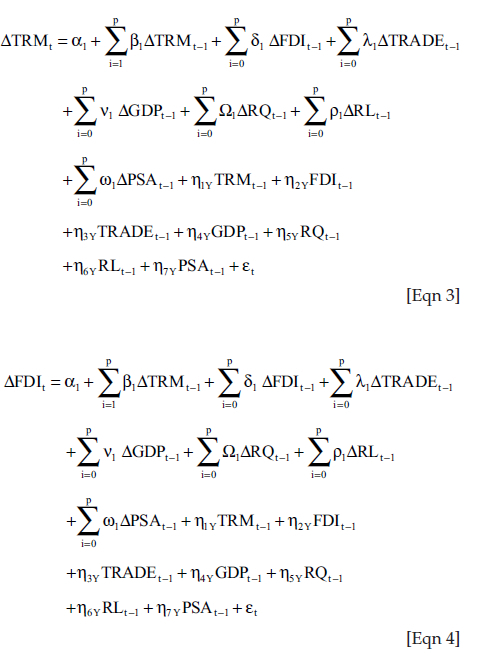
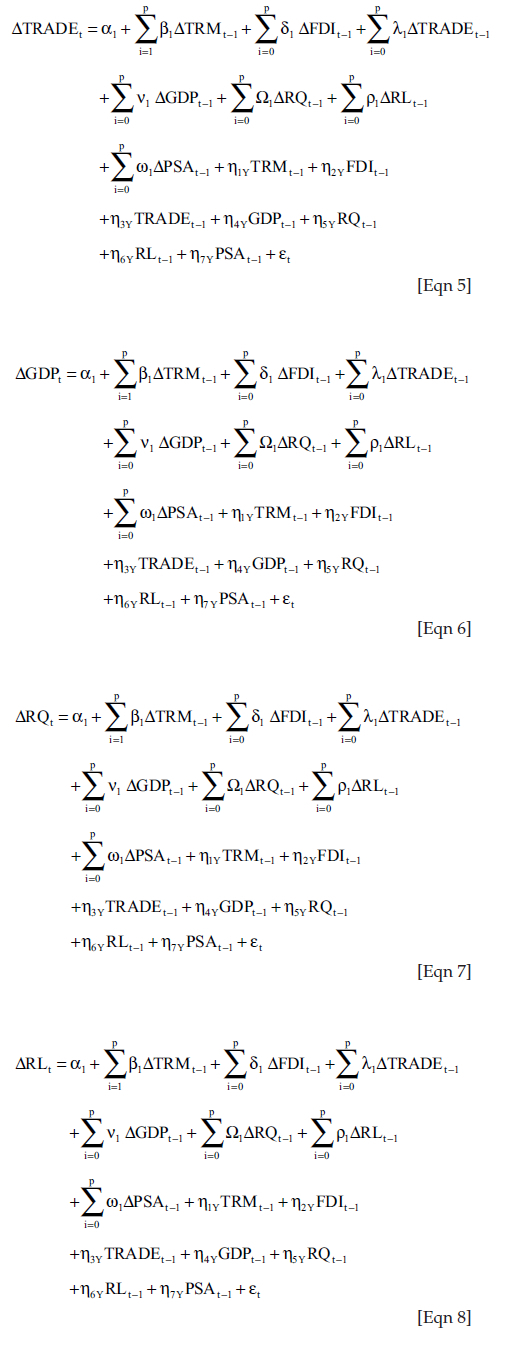
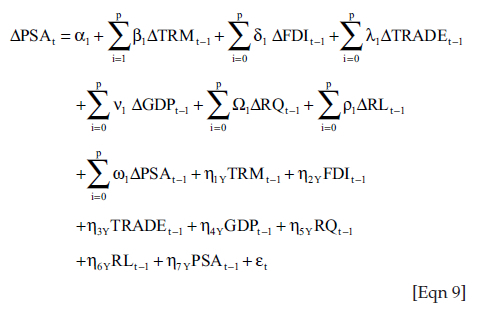
In Equations 3 to 9, α represents the intercept term, Δ is the first difference equator and parameter p represents the lag order. The long-term relationship between tourism inflow, FDI, international trade and institution quality variables such as the political stability and absence of violence, RL and RQ are evaluated by applying the F-test. The null hypothesis of no integration can be shown with H0 : α1 = δ1 = λ1 = ν1 = Ω1 = ρ1 = ω1, whereas the hypothesis of having cointegration or the alternative hypothesis is stated as H1 : α1 ≠ δ1 ≠ λ1 ≠ ν1 ≠ Ω1 ≠ ρ1 ≠ ω1.
Ethical considerations
Ethical clearance to conduct this study was obtained from the North-West University Economic and Management Sciences Research Ethics Committee (EMS-REC). (No. NWU-00081-21-A4).
Results
This section presents the empirical findings of the study which include the stationarity tests, ARDL bound tests, long and short-term tests and stability tests.
Stationarity tests
The stationarity properties of the variables are determined before adopting the cointegration approach with the test of unit-roots. Ordinarily, the unit root pre-testing is not a condition for the adoption of the ARDL approach, but rather to avoid misspecification of models and spurious results. The unit root tests were, therefore, employed in this study to ensure that there is no order (2) in the order of integration of the variables. The results of the unit root test are presented in Table 3.
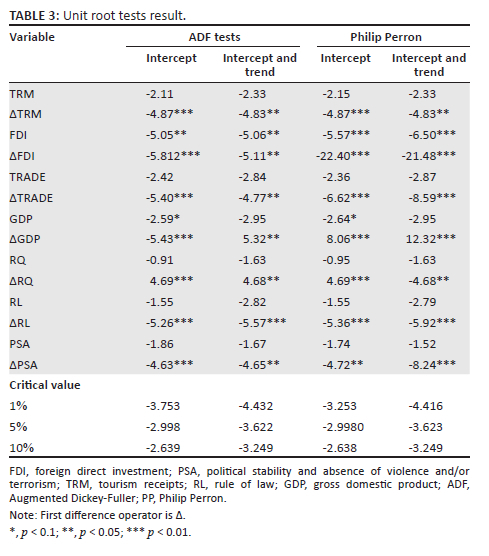
The outcome of the unit root test shows that all the variables except FDI are non-stationary at level but they became stationary in their first difference with a mixture of 1% and 5%. Foreign direct investment was, however, stationary at 5% for the augmented Dickey-Fuller tests and 1% for the Philip Perron. Gross domestic product was also stationary at the 10% level.
Autoregressive distributed lag cointegration tests
The unit root tests reveal a mixture of stationarity at the level and first difference that reveals that the study can proceed with other steps of conducting the ARDL tests given the null hypothesis that there is no cointegration among the variables and the alternative hypothesis is that there is cointegration among the variables. The selection of optimal lag that minimises the Akaike information criterion (AIC), final prediction error criterion (FPE), Schwarz information criterion (SIC) and Hannan Quinn criterion (HQ) were then estimated (Table 4).
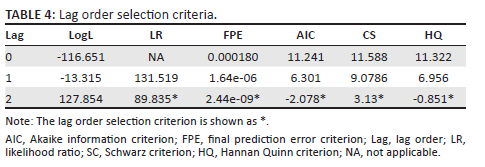
It can be seen from the result of the optimum lag selection method that the maximum lag length of 2 was selected for the bound tests by comparing the F-test statistics with upper and lower critical values of the bound tests of cointegration.
The bound test results presented in Table 5 were computed following the formula of Narayan (2005) by measuring the F-statistics against the critical bound values with tourism inflow as our dependent variable. The F-statistic is remarkably high at 109.76 compared to the upper bound value at a 1% level of significance that is of value 3.99. The result shows that there is cointegration among the dependent variable (tourism inflows) and the explanatory variables, which are FDI, international trade and institution quality variables such as the political stability and absence of violence, RL and RQ. The null hypothesis of no cointegration among the variables is, therefore, rejected. After identifying that there is cointegration among the variables, the long-term and short-term relationships among the variables were estimated by adopting the approach.
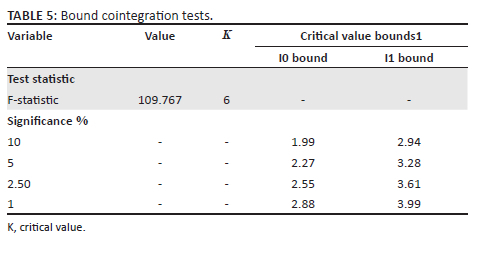
Long-term estimates
The result of the long-term coefficients is given in Table 6. TRADE has a positive and significant relationship with tourism inflows at 5% significance in the long term, which implies that an increase in tourism inflows will have a positive impact on international trade. It can also be better stated that a 1% change in tourism inflow will result in a 33% change in international trade in the long term. There is also a positive and significant relationship at 5% significance between RQ as institutional quality and the level of tourism inflow, implying that an increase in RQ will lead to an increase in tourism inflow in the long term, which is consistent with the findings of Ghalia et al. (2019).
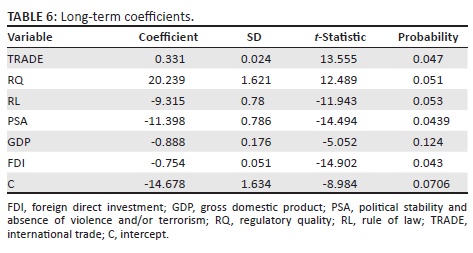
The RL as an institutional quality shows a negative and significant relationship with tourism inflow in South Africa. Political stability and absence of violence also show a negative relationship with the level of tourism inflows at 5% significance, which implies that the level of PSA in South Africa has not increased the level of tourism inflows within the review period. Gross domestic product also shows a negative and insignificant relationship with the level of tourism inflow in South Africa, indicating that the number of tourism inflows in South Africa is not enough to have a positive change in GDP. There is a significant and negative relationship between FDI and the level of tourism inflow in South Africa.
Short-term estimates
Table 7 indicates the result of the short-term dynamic relationship between the tourism inflow and the explanatory variables; FDI, international trade and institution quality variables such as the RL, politics, stability and absence of violence and the RQ. The lag error term (ECTt-1), which is the speed of adjustment of tourism inflow to shock, has a negative coefficient of 1.02 at a 5% significance level. This implies that there is a strong relationship between tourism inflow and FDI, international trade, political stability and absence of violence, RL and RQ. The results also indicate that any deviation from the long-term equilibrium from an external effect in a particular year will be fully corrected in the subsequent year. The results show that there is a positive and significant relationship at 5% between tourism inflow, RQ and TRADE in the short term. There is also a negative and significant relationship at a 10% level of significance between tourism, political stability and the absence of violence in the short term. There is a negative and insignificant relationship between tourism inflow, FDI and GDP in the short term.
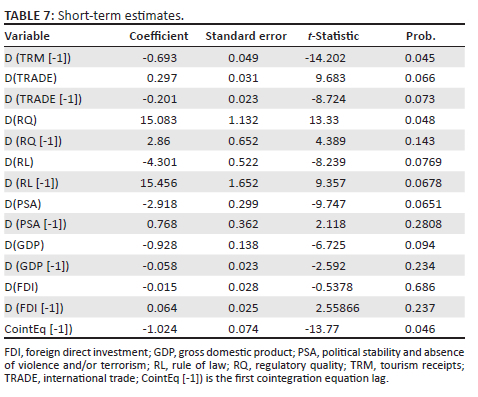
Diagnostic tests
The diagnostic tests will be conducted in this study to determine if there are any observations that are not well-represented in the regression model.
Normality test: The normality test is conducted to determine the level of distribution of data or variables in a group or to find out if the data or variables are normally distributed or not.
The normality test result is determined by adopting the Jarque-Bera approach and shows that the jar value is 2.126271 with the probability value of 0.569421 ˃ 0.05 which simply implies that the data can be concluded to be normal and the H0 cannot be rejected (see Figure 3).
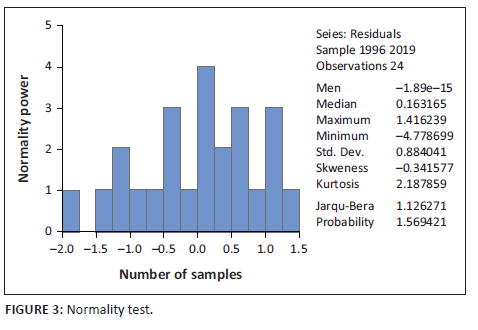
Heteroscedasticity test: The heteroscedasticity test is used to measure whether the variance or error that is present in the regression equation was caused by the utilised independent variable.
The result of the Heteroscedasticity test by utilising the Breusch-Pagan-Godfrey test in Box 1 can be concluded that as the value of the Observation multiplied by R-squared is 11.20903 and the Chi-Squared probability value is 0.0821 ˃ 0.05, H0 cannot be rejected which implies that the regression model is homoscedastic and not with the problem of heteroscedasticity.

Serial correlation LM test: The result of the serial correlation LM test by adopting the Breusch-Godfrey test in Box 2 shows that the Observation multiplied by R-squared is 2.1070.05 and the Chi-Squared probability value is 0.3486. This illustrates that a null hypothesis of no serial correlation can be accepted at the 5% level of significance. That is, the regression model is from the problem of serial correlation.

Ramsey RESET test: The result of the probability of the t-statistic, F-statistic and the probability of the fitted line square in the table are equal at 0.0068, hence the null hypothesis of no misspecification in the model is accepted (Table 8).
Detection of multicollinearity based on variance inflation: In Table 9, the centred VIF values for FDI, GDP, PSA, RL, RQ and TRADE have their values less than 10. It, therefore, can be concluded that there is an absence of the multicollinearity problem present with the regression model utilised in the study.
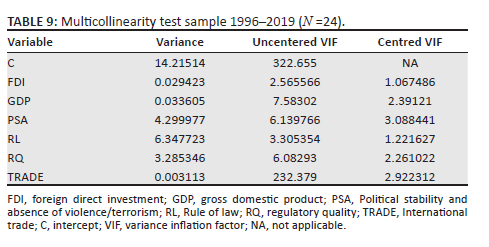
In a bid to confirm the robustness of the econometric results and to confirm the position of the serial correlation and heteroscedasticity test, the cumulative sum (CUSUM) and cumulative sum of squares (CUSUMS) of recursive residual tests were adopted. The tests indicate that the model is stable, there is an absence of heteroscedasticity and there is no serial correlation, as indicated in Figures 4 and 5.
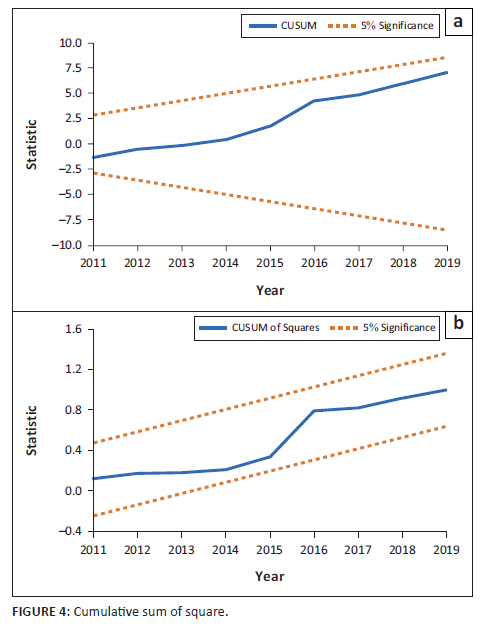
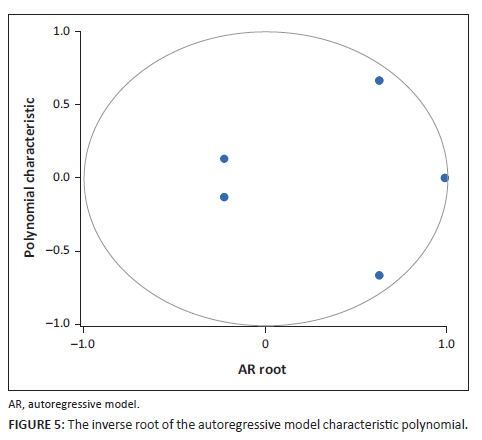
Granger causality test
Table 10 presents the Toda-Yamamoto results of the Granger causality assessment to analyse the long-term relationships among the variables. Unlike the traditional causality tests, such as the VECM, which require unit root testing first, the Toda-Yamamoto Granger causality tests do not require pre-testing before it is conducted. The Toda-Yamamoto approach, unlike the Granger causality assessment, does not require that the series should be stationary or cointegrated before conducting the tests (Aziz et al. 2000; Menyah & Wolde-Rufael 2010; Rambaldi & Doran 1996). Toda and Yamamoto (1995) adopted a simple technique that requires conducting an 'augmented' value at risk (VAR) for the distribution of the MWald statistic despite the existence of cointegration among the variables. This technique of causality requires the determination of the maximal order of integration (dmax). The (dmax) indicates that the VAR model will add a lag to the existing lag (Aziz et al. 2000). After adopting the (dmax) to conduct our causality tests, the stability of the model was evaluated using the unit circle test (Figure 5). If the reverse roots are within the unit circle, then the assumption is that the model is dynamically stable.
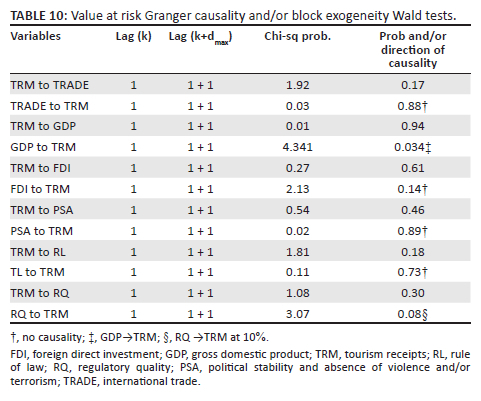
Table 10 indicates that there is no causality between international trade and tourism inflow for South Africa within the review period. This result implies that the change in tourism has not done enough to promote international trade, and vice versa. There is also no causality between tourism and FDI. The result shows that the change in tourism inflow has not caused a change in the amount of FDI inflow and vice versa. The result also indicates a one-way causality running from GDP to tourism inflow, implying that a change in GDP growth has resulted in the change in tourism inflow in South Africa without corresponding feedback from tourism inflow to GDP; this result is consistent with the research findings of Kebede and Takyi (2017).
The results in Table 10 also indicate that there is a unidirectional causality running from RQ as a proxy of institutional quality to tourism inflow in South Africa. This result implies that a change in RQ caused a change in the volume of tourism inflow in South Africa. The other two institutional-quality proxies, which are the RL and political stability, and the absence of violence, however, show the absence of causality with tourism inflow in South Africa. This result implies that the change in the RL and political stability, and the absence of violence, have not done enough to cause a change in the volume of tourism inflow to South Africa within the review period.
Conclusion
This article investigates the impact of IQ, FDI and TRADE on TRM in South Africa. An empirical investigation of tourism inflow as the dependent variable being expressed as a function of GDP, FDI, international trade and some institutional quality proxies such as RL, RQ, political stability and absence of violence, was conducted. The motivation was prompted by a need to redirect the focus, as much attention has been directed towards the assessment of risk in conducting business with foreigners and neglecting the risks that tourists need to assess before going to other countries for different activities in tourism, which will directly expose them to the opportunities of conducting business with or bringing business to the countries.
Adopting the ARDL and Toda-Yamamoto approach to Granger causality tests, the result shows cointegration among the variables, a positive relationship between international and tourism inflow in the long term, a positive relationship between RQ and tourism inflow in the short- and long-term. This result implies that a good regulatory institution would assist the South Africa other African countries to improve the inflow of tourism into the country which will boost the revenue generated in the country and the relationship with other countries. The study also established a negative relationship among tourism inflow and GDP in the short and long term. This result implies that the tourism inflow into South Africa within the review period was not sufficient enough to cause a substantial improvement on the economy. The study found a one-way causality from GDP to tourism inflow. This outcome is consistent with the long and short terms relationship between GDP and tourism inflow as the volume of tourism inflow has not produced considerable impact on the GDP of South Africa. The study also found unidirectional causality running from RQ to tourism inflow in South Africa. This result implies that the RL and political stability, and the absence of violence, have produced significant impact on the volume of tourism inflow to South Africa within the review period but the volume of tourism inflow has not done likewise.
The main conclusion that can be highlighted from this study is that a good regulatory framework will assist in improving the volume of investments and tourist attractions in South Africa. This implies that an improvement in the volume of tourism inflows into South Africa and other SSA countries will assist in economic growth, as well as increase FDIs and other forms of international trade. This study, therefore, recommends that countries should ensure the availability and implementation of policies that can assist to enforce quality institutions that assist to enforce adequate institutional quality that may promote the volume of tourism inflows into the country.
Acknowledgements
Competing interests
The authors declare that they have no financial or personal relationships that may have inappropriately influenced them in writing this article.
Authors' contributions
Both authors contributed to the article. O.J.I. conducted the literature study, empirical analysis and wrote the initial manuscript. E.P.J.K. overviewed and validated the empirical analysis and wrote the final version of the manuscript. O.J.I. is a post-doctoral fellow and E.P.J.K. is the supervisor.
Funding information
The authors acknowledge the support from the World Trade Organization (WTO) and the National Research Foundation (NRF). The findings, views and opinions expressed and conclusions arrived at in this article are those of the authors and should not necessarily be attributed to the funding institutions.
Data availability
The research was conducted using freely available data from various sources as indicated clearly in the article.
Disclaimer
The views and opinions expressed in this article are those of the authors and do not necessarily reflect the official policy or position of any affiliated agency of the authors.
References
Abubakar, S., 2020, 'Institutional quality and economic growth: Evidence from Nigeria', African Journal of Economic Review 8(1), 48-64. [ Links ]
Adegboye, F.B., Osabohien, R., Olokoyo, F.O., Matthew, O. & Adediran, O., 2020, 'Institutional quality, foreign direct investment, and economic development in sub-Saharan Africa', Humanities and Social Sciences Communications 7(1), 1-9. https://doi.org/10.1057/s41599-020-0529-x [ Links ]
Ali, F.A., Fiess, N. & MacDonald, R., 2010, 'Do institutions matter for foreign direct investment?', Open Economies Review 21(2), 201-219. https://doi.org/10.1007/s11079-010-9170-4 [ Links ]
Álvarez, I.C., Barbero, J., Rodríguez-Pose, A. & Zofío, J.L., 2018, 'Does institutional quality matter for trade? Institutional conditions in a sectoral trade framework', World Development 103, 72-87. https://doi.org/10.1016/j.worlddev.2017.10.010 [ Links ]
Anwar, Z. & Afza, T., 2014, 'Impact of terrorism, gas shortage and political instability on FDI inflows in Pakistan', Science International 26(1), 507-511. [ Links ]
Asamoah, M.E., Adjasi, C.K. & Alhassan, A.L., 2016, 'Macroeconomic uncertainty, foreign direct investment and institutional quality: Evidence from Sub-Saharan Africa', Economic Systems 40(4), 612-621. https://doi.org/10.1016/j.ecosys.2016.02.010 [ Links ]
Asghar, N., Qureshi, S. & Nadeem, M., 2015, 'Institutional quality and economic growth: Panel ARDL analysis for selected developing economies of Asia', South Asian Studies 30(2), 381. [ Links ]
Asiedu, E., 2002, 'On the determinants of foreign direct investment to developing countries: Is Africa different?', World Development 30(1), 107-119. https://doi.org/10.1016/S0305-750X(01)00100-0 [ Links ]
Asiedu, E., 2005, The role of natural resources, market size, government policy, institutions and political instability, World Institute for Development Economics Research, Working Paper, No. 2005/24, United Nations University. [ Links ]
Asiedu, E., 2006, 'Foreign direct investment in Africa: The role of natural resources, market size, government policy, institutions and political instability', World Economy 29(1), 63-77. https://doi.org/10.1111/j.1467-9701.2006.00758.x [ Links ]
Asif, M. & Majid, A., 2018, 'Institutional quality, natural resources and FDI: Empirical evidence from Pakistan', Eurasian Business Review 8(4), 391-407. https://doi.org/10.1007/s40821-017-0095-3 [ Links ]
Aziz, M.A., Habibullah, M.S., Azman-Saini, W.N.W. & Azali, M., 2000, 'Testing for causality between taxation and government spending: An application of Toda-Yamamoto approach', Pertanika Journal of Social Science and Humanities 8(1), 45-50. [ Links ]
Balli, F., Balli, H.O. & Louis, R.J., 2016, 'The impacts of immigrants and institutions on bilateral tourism flows', Tourism Management 52, 221-229. https://doi.org/10.1016/j.tourman.2015.06.021 [ Links ]
Bouchoucha, N. & Benammou, S., 2020, 'Does institutional quality matter foreign direct investment? Evidence from African countries', Journal of the Knowledge Economy 11, 390-404. https://doi.org/10.1007/s13132-018-0552-y [ Links ]
Brini, R., Amara, M. & Jemmali, H., 2017, 'Renewable energy consumption, international trade, oil price and economic growth inter-linkages: The case of Tunisia', Renewable and Sustainable Energy Reviews 76, 620-627. https://doi.org/10.1016/j.rser.2017.03.067 [ Links ]
Buchanan, B.G., Le, Q.V. & Rishi, M., 2012, 'Foreign direct investment and institutional quality: Some empirical evidence', International Review of Financial Analysis 21, 81-89. https://doi.org/10.1016/j.irfa.2011.10.001 [ Links ]
Butkiewicz, J.L. & Yanikkaya, H., 2006, 'Institutional quality and economic growth: Maintenance of the rule of law or democratic institutions, or both?', Economic Modelling 23(4), 648-661. https://doi.org/10.1016/j.econmod.2006.03.004 [ Links ]
Chaib, B. & Siham, M., 2014, 'The impact of institutional quality in attracting foreign direct investment in Algeria', Topics in Middle Eastern and African Economies 16(2), 142-163. [ Links ]
Department of Trade and Industry (DTI), 2021, Industrial Policy Action Plan, 2018/19 2020/21, DTI, Pretoria. [ Links ]
Dollar, D. & Kraay, A., 2000, Property rights, political rights, and the development of poor countries in the post-colonial period, World Bank Working Papers, World Bank, Washington, DC. [ Links ]
Epo, B.N. & Nochi Faha, D.R., 2020, 'Natural resources, institutional quality, and economic growth: An African tale', European Journal of Development Research 32(1), 99-128. https://doi.org/10.1057/s41287-019-00222-6 [ Links ]
Esew, N.G. & Yaroson, E., 2014, 'Institutional quality and foreign direct investment (FDI) in Nigeria: A prognosis', IOSR Journal of Humanities and Social Science 19(6), 37-45. https://doi.org/10.9790/0837-19653745 [ Links ]
Fukumi, A. & Nishijima, S., 2010, 'Institutional quality and foreign direct investment in Latin America and the Caribbean', Applied Economics 42(14), 1857-1864. https://doi.org/10.1080/00036840701748979 [ Links ]
Ghalia, T., Fidrmuc, J., Samargandi, N. & Sohag, K., 2019, 'Institutional quality, political risk and tourism', Tourism Management Perspectives 32, 100576. https://doi.org/10.1016/j.tmp.2019.100576 [ Links ]
Greif, A., 2006, Institutions and the path to the modern economy: Lessons from medieval trade, Cambridge University Press, Cambridge. [ Links ]
Henama, U.S., 2013, 'Attracting Indian outbound tourist to South Africa: A BRICS perspective', India Quarterly: A Journal of International Affairs 69(3), 229-247. https://doi.org/10.1177/0974928413489466 [ Links ]
Henama, U.S., 2018, 'Disruptive entrepreneurship using Airbnb: The South African experience', African Journal of Hospitality, Tourism and Leisure 7(1), 1-16. [ Links ]
Ibrahim, M.H. & Law, S.H., 2016, 'Institutional quality and CO2 emission-trade relations: Evidence from sub-Saharan Africa', South African Journal of Economics 84(2), 323-340. https://doi.org/10.1111/saje.12095 [ Links ]
Ionannides, D. & Timothy, D.J., 2010, Tourism in the USA: A spatial and social synthesis, Routledge, London. [ Links ]
Jadhav, P., 2012, 'Determinants of foreign direct investment in BRICS economies: Analysis of economic, institutional and political factor', Procedia-Social and Behavioural Sciences 37, 5-14. https://doi.org/10.1016/j.sbspro.2012.03.270 [ Links ]
Jogaratnam, G., Chon, K., McCleary, K., Mena, M. & Yoo, J., 2005, 'An analysis of institutional contributors to three major academic tourism journals: 1992-2001', Tourism Management 26(5), 641-648. https://doi.org/10.1007/978-1-349-15068-7_3 [ Links ]
Jude, C. & Levieuge, G., 2016, 'Growth effect of foreign direct investment in developing economies: The Role of institutional quality', World Economy 40(4), 715-742. https://doi.org/10.1111/twec.12402 [ Links ]
Kebede, J.G. & Takyi, P.O., 2017, 'Causality between Institutional Quality and Economic Growth: Evidence from Sub-Saharan Africa', European Journal of Economic and Financial Research 2(1), 114-131. [ Links ]
Keefer, P. & Knack, S.F., 1995, Polarization, property rights, and the links between inequality and growth, Center for Institutional Reform and the Informal Sector, University of Maryland, College Park. [ Links ]
Khan, M.A., Popp, J., Talib, M.N.A., Lakner, Z. & Oláh, J., 2020, 'Asymmetric impact of institutional quality on tourism inflows among selected Asian Pacific countries', Sustainability 12(3), 1223. https://doi.org/10.3390/su12031223 [ Links ]
Kim, Y.R., Saha, S., Vertinsky, I. & Park, C., 2018, 'The impact of national institutional quality on international tourism inflows: A cross-country evidence', Tourism Analysis 23(4), 533-551. https://doi.org/10.3727/108354218X15391984820503 [ Links ]
Menyah, K. & Wolde-Rufael, Y., 2010, 'Energy consumption, pollutant emissions and economic growth in South Africa', Energy Economics 32(6), 1374-1382. https://doi.org/10.1016/j.eneco.2010.08.002 [ Links ]
Meo, M., Nathaniel, S., Shaikh, G. & Kumar, A., 2021, 'Energy consumption, institutional quality and tourist arrival in Pakistan: Is the nexus (a) symmetric amidst structural breaks?', Journal of Public Affairs 21(2), e2213. https://doi.org/10.1002/pa.2213 [ Links ]
Meon, P.G. & Sekkat, K., 2007, Revisiting the relationship between governance and foreign direct investment, Working Paper no. 07-13.RS, Université Libre de Bruxelles, Brussels. [ Links ]
Mishra, A. & Daly, K., 2007, 'Effect of quality of institutions on outward foreign direct investment', Journal of International Trade and Economic Development 16(2), 231-244. https://doi.org/10.1080/09638190701325573 [ Links ]
Muhammad, A., Hashim, K., Imran, H., Mushtaq, A.H. & Irfan, C.M., 2011, Institutions, macroeconomic policy and foreign direct investment: South Asian countries case, Munich Personal RePEc Archive paper, 32480, viewed n.d., from http://mpra.ub.uni-muenchen.de/32480/1/Institutions_macroeconomc_policy_and_foreign_direct_investment-South_Asian_countries_case.pdf. [ Links ]
Mushtaq, R., Thoker, A.A. & Bhat, A.A., 2021, 'Does institutional quality affect tourism demand? Evidence from India', Journal of Hospitality and Tourism Insights 4(5), 622-638. https://doi.org/10.1108/JHTI-05-2020-0088 [ Links ]
Narayan, P.K., 2005, 'The saving and investment nexus for China: Evidence from cointegration tests', Applied Economics 37(17), 1979-1990. https://doi.org/10.1080/00036840500278103 [ Links ]
Nathaniel, S.P., 2020, 'Modelling urbanization, trade flow, economic growth and energy consumption with regards to the environment in Nigeria', GeoJournal 85(6), 1499-1513. https://doi.org/10.1007/s10708-019-10034-0 [ Links ]
Neumayer, E., 2004, 'The impact of political violence on tourism: Dynamic cross-national estimation', Journal of Conflict Resolution 48(2), 259-281. https://doi.org/10.1177/0022002703262358 [ Links ]
Nkoro, E. & Uko, A.K., 2016, 'Autoregressive distributed lag (ARDL) cointegration technique: Application and interpretation', Journal of Statistical and Econometric Methods 5(4), 63-91. [ Links ]
Nondo, C., Kahsai, M.S. & Hailu, Y.G., 2016, 'Does institutional quality matter in foreign direct investment?: Evidence from sub-Saharan African countries', African Journal of Economic and Sustainable Development 5(1), 12-30. https://doi.org/10.1504/AJESD.2016.074441 [ Links ]
North, D.C., 1990, Institutions, institutional change and economic performance, Cambridge University Press, Cambridge. [ Links ]
Pasaran, S.H., Shine, Y. & Smith, R.J., 2001, 'Bound testing approach to the analysis of level relationship', Journal of Applied Econometrics 16(3), 289-326. https://doi.org/10.1002/jae.616 [ Links ]
Rambaldi, A.N. & Doran, H.E., 1996, Testing for Granger non-causality in cointegrated systems made easy, Department of Econometrics, University of New England, Armidale. [ Links ]
Rodrik, D., 1999, 'Where did all the growth go? External shocks, social conflict, and growth collapse', Journal of Economic Growth 4(4), 385-412. https://doi.org/10.1023/A:1009863208706 [ Links ]
Salman, M., Long, X., Dauda, L. & Mensah, C.N., 2019, 'The impact of institutional quality on economic growth and carbon emissions: Evidence from Indonesia, South Korea and Thailand', Journal of Cleaner Production 241, 118331. https://doi.org/10.1016/j.jclepro.2019.118331 [ Links ]
Schneider, F. & Frey, B.S., 1985, 'Economic and political determinants of foreign direct investment', World Development 13(2), 161-175. https://doi.org/10.1016/0305-750X(85)90002-6 [ Links ]
Sinclair, M.T. & Stabler, M., 1997, The economics of tourism, Routledge, London. [ Links ]
Soeng, R., Cuyvers, L. & Sok, S., 2017, Do institutions matter for Foreign Direct Investment in Cambodia?, CAS Discussion Paper no. 101, Centre for International Management and Development, Antwerp. [ Links ]
Teles, V.K., 2007, 'Institutional quality and endogenous economic growth', Journal of Economic Studies 34(1), 29-41. https://doi.org/10.1108/01443580710717200 [ Links ]
Toda, H.Y. & Yamamoto, T., 1995, 'Statistical inference in vector autoregressions with possibly integrated processes', Journal of Econometrics 66(1-2), 225-250. https://doi.org/10.1016/0304-4076(94)01616-8 [ Links ]
Tsai, P.L., 1994, 'Determinants of foreign direct investment and its impact on economic growth', Journal of Economic Development 19(1), 137-163. [ Links ]
Wadhawan, S. & Kandiero, T., 2003, 'Institutional quality, openness, and investment in Africa', South African Journal of Economic and Management Sciences 6(2), 346-368. https://doi.org/10.4102/sajems.v6i2.3318 [ Links ]
World Bank, 2022a, World Bank website, World Bank, Washington, viewed 13 October 2022, from https://www.worldbank.org/en/home. [ Links ]
World Bank, 2022b, World Bank indicator, World Bank, Washington, viewed 13 October 2022, from https://data.worldbank.org/indicator. [ Links ]
World Trade Organization (WTO) 2004, World trade report 2004, WTO, Geneva. [ Links ]
Yakubu, I.N., 2020, 'Institutional quality and foreign direct investment in Ghana: A bounds-testing cointegration approach', Review of International Business and Strategy 30(1), 109-122. https://doi.org/10.1108/RIBS-08-2019-0107 [ Links ]
 Correspondence:
Correspondence:
Ewert Kleynhans
epjkleynhans@gmail.com
Received: 13 Oct. 2022
Accepted: 05 May 2023
Published: 11 Aug. 2023














